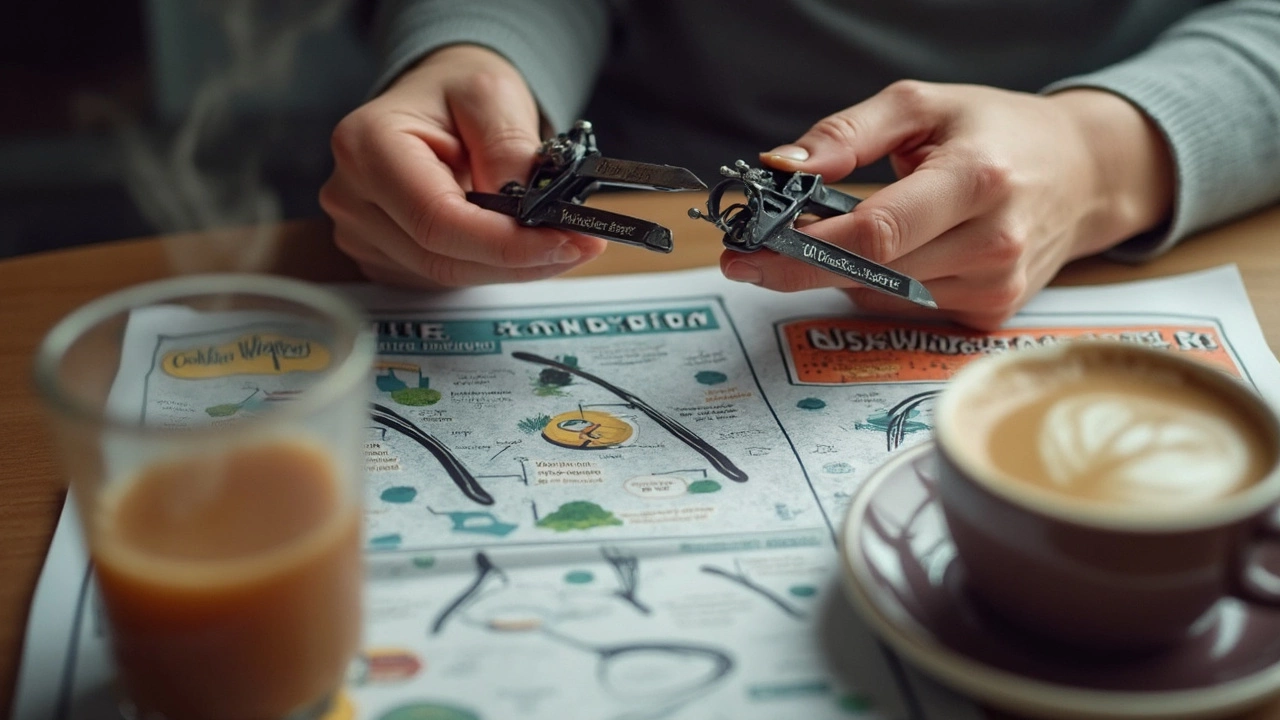Ever asked for windscreen wipers in an American auto parts store and gotten blank stares? You're probably using the wrong word. In the US, they're called windshield wipers. If you're shopping, asking a mechanic, or just chatting about cars, 'windshield wipers' is the term that gets you what you want.
This mix-up happens a lot, especially for folks who travel or shop for car parts online. American English sticks with 'windshield,' while British English goes with 'windscreen.' Different word, same job—clearing away rain, snow, and grime so you can actually see the road.
- Windshield Wipers vs. Windscreen Wipers: The Terminology Divide
- A Quick Look at the History
- Why the Naming Difference Matters
- Useful Tips for American Drivers
- Surprising Wiper Facts You Haven't Heard
Windshield Wipers vs. Windscreen Wipers: The Terminology Divide
If you’re driving in the US and talking about the piece of rubber that keeps your vision clear in the rain, just say windshield wipers. In the UK, Ireland, Australia, and a bunch of other countries, folks swear by ‘windscreen wipers’. The terms are like siblings—same DNA, different nicknames depending on where you’re hanging out.
The difference comes down to language evolution. ‘Windscreen’ stuck in places following British English, while ‘windshield’ is pure American lingo. The word ‘windshield’ actually dates back to horse-drawn carriages, when panels were used to shield passengers from wind and debris. By the time cars were everywhere, Americans were already used to saying ‘windshield’. Brits chose ‘windscreen’ because, well, it sounded like a screen keeping the wind at bay.
You might be wondering: does the US ever use ‘windscreen’? Not really. Car manuals, mechanics, and even the Department of Transportation all go with ‘windshield’. Here’s what the US National Highway Traffic Safety Administration says:
"Windshield wipers are a key safety feature, improving visibility for drivers in all weather conditions."
Check out this quick-look table for where you'll hear each term:
| Country | Term Used |
|---|---|
| United States, Canada | Windshield Wipers |
| UK, Ireland, Australia, New Zealand | Windscreen Wipers |
This stuff matters more than just for word nerds. If you’re traveling, buying parts, or reading online guides, knowing the right word can save you time and a whole lot of confusion.
A Quick Look at the History
The idea for windshield wipers actually popped up way before cars had all their modern bells and whistles. Back in 1903, Mary Anderson from Alabama got tired of not being able to see out her streetcar window during rain, so she designed the first hand-operated wiper. Smart move, right? Her patent was granted in 1903, years before automatic wipers became a thing.
It wasn’t until 1917 that Charlotte Bridgwood created an electric windshield wiper, making it way easier to drive in the rain. But even then, it took a while before these became standard on every car. Car makers only started adding them to all their models around the 1920s and 30s.
Here's a quick timeline of big moments for wipers:
- 1903: Anderson’s manual lever wiper gets patented.
- 1917: Bridgwood invents the electric wiper.
- 1920s: Vacuum-powered wipers show up.
- 1960s: Interval and two-speed wipers enter the scene.
- 1970s: The first rain-sensing wipers get tested.
Now, almost every car in America comes with two or more wipers, and you sometimes find fancy ones with built-in sprayers or rain sensors. Check out this quick table for a snapshot of wiper adoption through the years:
| Year | Invention/Event | Notes |
|---|---|---|
| 1903 | Manual wiper patented | First design, operated by hand inside the vehicle |
| 1917 | Electric wiper invented | No more manual effort needed |
| 1920s-30s | Industry-wide adoption | Became a standard safety feature |
| 1960s | Interval settings | Drivers could adjust speed for rain levels |
| 1970s+ | Rain-sensing & modern tech | Automatic adjustment to rainfall |
So next time your wipers clear off a storm in seconds, you can thank a couple of smart inventors from over a century ago—and get why Americans ended up calling them something different than the Brits.

Why the Naming Difference Matters
If you’re looking for windshield wipers in America but ask for 'windscreen wipers,' things can get confusing fast. This isn't just a funny language quirk—it actually affects shopping, repairs, and even online searches. American parts shops won’t always recognize the British term, so you could leave empty-handed or grab the wrong item.
The words are tied to how each country names parts of a car. Americans say 'windshield' because it shields you from the wind; Brits use 'windscreen,' which literally means a screen for the wind. Even big automakers mark replacement parts, instructions, and maintenance records using their home country’s term, which only adds to the confusion.
"In the US, using the correct part name matters, whether you’re buying car parts or reading a repair guide. One wrong word, and you might get the wrong part or miss out on the right help." – AutoZone Training Manager, 2023
Mixing up terms can even impact your search results. A 2022 database review showed Americans type 'windshield wipers' in Google 30 times more often than 'windscreen wipers.' If you’re searching online for how to fix or replace them, using the British term means you’ll see UK-based content, which usually isn’t as helpful for American vehicles or brands.
| Term | Country | Monthly Online Searches (2024, US) |
|---|---|---|
| Windshield wipers | USA | 301,000 |
| Windscreen wipers | UK | 41,000 |
So, using the right phrase saves you time, gets you the right advice, and helps you find what you need without hassle. It’s a tiny detail, but it makes all the difference for drivers and DIYers.
Useful Tips for American Drivers
Wiper blades might seem like an afterthought, but good ones can mean the difference between seeing clearly and, well, not seeing much at all. Since Americans call them windshield wipers, that's the magic phrase whenever you need a replacement.
Here’s the thing—most brands in the US recommend changing blades every 6 to 12 months. If you spot streaks, hear squeaking, or notice your wipers leave patches untouched, it's time for a swap. Always check your owner’s manual for the right size and connector type before buying new blades. American cars vary wildly, so what fits a Ford F-150 won’t always fit a Chevy Malibu.
When installing new wipers, take your time. A lot of modern wiper arms have snap-on connectors, but older cars might have hook or pin types. Don’t force anything—if it feels stuck, there could be a latch you missed.
- Never run your wipers dry. It wears out the rubber fast and can scratch your windshield.
- If you live where it snows, look for winter-specific wipers. They’re built to fight ice buildup.
- Clean your windshield regularly with glass cleaner. Dirt and grit eat up wiper blades in no time.
- Lift your wipers up when parking outside in icy weather, so they don’t stick to the glass.
One more tip: Check your washer fluid often. American cars almost always have the washer fluid cap labeled in English, usually bright blue or yellow, so you can’t miss it.
In a rush? Most quick oil change places in the US will switch out wipers for you on the spot if you buy the blades there. Super handy if you’re not into wrestling with wiper arms in a parking lot.

Surprising Wiper Facts You Haven't Heard
Get this—windshield wipers were actually invented by a woman. Mary Anderson patented the first working wiper in 1903 after seeing frustrated trolley drivers battling the rain. Back then, wipers were operated by hand with a crank inside the car, which sounds like a real hassle compared to today's automatic systems.
While most folks think wipers are basically the same everywhere, drivers in places with heavy snow often use winter-specific blades. These have rubber covers that keep ice from jamming up the mechanism. It's not just about clearing off rain—proper wipers can also make a big difference when it comes to safety, because the National Highway Traffic Safety Administration (NHTSA) once reported that visibility issues, like dirty or worn wipers, play a part in several thousand crashes every year.
Check out these fast stats:
| Fact | Details |
|---|---|
| First patent for wipers | 1903, by Mary Anderson |
| Automatic wipers introduced | 1920s (Cadillac, vacuum-powered) |
| Recommended wiper replacement | Every 6-12 months |
| Accidents linked to poor visibility (US yearly) | Over 46,000, according to NHTSA |
Maybe you’ve never noticed, but not all wipers move in the same pattern. Some cars use a single blade that arcs over the glass, while others use two blades that move in opposite directions. There’s even a Mercedes from a few years back with a mono wiper featuring its own tiny washer jets to clean super efficiently. It’s more than just sliding rubber—they’ve come a long way.
Here’s a short list of things you probably didn’t know your windshield wipers handle for you:
- Some start working automatically when it rains, thanks to rain sensors—standard in most newer cars.
- Heated wipers or wiper zones exist for icy places, melting snow so the blades don’t freeze up.
- Wipers can dry out and crack even if you barely use your car, especially in hot sunny states.
- Performance wipers for trucks and SUVs are reinforced to handle bug splats, mud, and heavy rain.
- Replacing wipers is one of the cheapest, fastest upgrades you can make for driver safety.
If your wipers smear water or make screechy noises, it’s time for new ones. Old blades can turn a short drive in the rain into a nerve-racking experience. Keep an eye out for streaks, missed spots, or cracked rubber. That quick fix makes a bigger difference than most people think.


